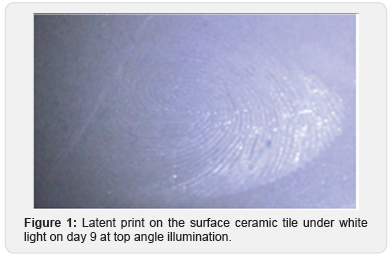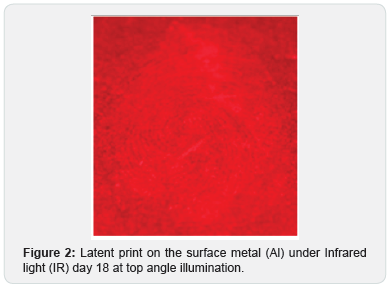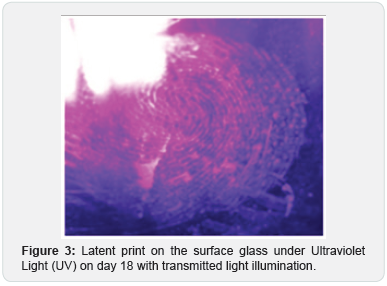Study on Efficiency of Alternate Light Source for Detection of Latent Fingerprints
Peter Kiran A* and Dakshinamurthy Sridevi
Department of Forensic Science, Jain University, India
Submission: July 06, 2018;Published: July 12, 2018
*Corresponding author: Peter Kiran A, Department of Forensic Science, Jain University, India, Tele: 8971435885; Email: peterkiran.a@gmail.com
How to cite this article: Peter Kiran A, Dakshinamurthy S. Study on Efficiency of Alternate Light Source for Detection of Latent Fingerprints. J Forensic Sci & Criminal Inves 2018; 9(5): 555774. DOI:10.19080/JFSCI.2018.09.555774.
Abstract
Latent prints being the most common form of evidence at a crime scene, links the person directly to the crime scene and needs to be detected and collected using a non-destructive method which includes the use of light sources and different illumination methods. It is known that detecting fresh latent prints at a crime scene using light sources is quite easy, but using the light sources to detect latent prints which have been deposited over a period of time is a challenge. The purpose of the current study is to determine how long Alternate Light Source (ALS) can be used as an effective method in detecting latent prints which have been deposited on the surface over a period of time and by evaluating the quality of the latent prints and determining the best light source and the best illumination method for detecting and photographing the latent prints.
keywords: Latent prints; Alternate Light sources; Ultraviolet light; White light; Infrared light; Illumination method
Abbrevations: ALS: Alternate Light Source; UV: Ultraviolet Light; IR: Infrared Light; FLS: Forensic Light Source
Introduction
Fingerprint is defined as the raised ridges, which form accidentally during the development of the foetus, that cover the whole of the inner surface of the hand and the underside of the soles of the feet. The images of the ridges form a fingerprint. Fingerprints are unique and are still considered to be the best form of personal identification for criminal investigation purposes. They help in proving the presence or absence of a person at a crime scene. Fingerprints found at crime scenes can be categorized by some examiners as patent, plastic or latent impressions. A latent finger mark is an invisible print which needs to be developed to make it visible and they are the most common form of fingerprint evidence. Latent fingerprints are a hidden record on materials formed by perspiration and oil from the internal finger the form of ridges and furrows during friction or contact. Three primary glands contribute to the production of sweat: The sudoriferous glands (eccrine and apocrine) and the sebaceous glands. Latent print can be found on different surfaces classified as porous, non-porous, semi-porous and textured surfaces.
The following general procedures are appropriate during a systematic search for latent fingerprint evidence:
a. Visual inspection with a bright light, forensic light source, or laser
b. Sequential latent print processing
c. Documentation of developed prints at each step
Detection of latent prints being the primary step towards processing of latent prints, light sources are very helpful. In addition, prints developed using a physical or chemical process can generally be further enhanced using an appropriate light source such as ultraviolet light (UV), Infrared light (IR), high intensity white light, laser, led and Alternate Light Source (ALS) or Forensic Light Source (FLS). Alternate light source (ALS) is a portable, tunable multi waveband light source. It is made up of a powerful lamp containing the ultra-violet, visible and infrared components of light. It then filters down the light into individual colour bands (wavelengths) that enhance the visualization of evidence.
A study on the overview of the current techniques available to law enforcements agencies for detection and enhancement of latent finger marks on different surfaces conclude that UV reflection techniques have proven to be useful on a number of surfaces when short wave UV light is used (Dr. Chris Lennard). A study on the development of latent prints that involve using anti stokes phosphors requires an elimination source that emits infrared radiations. It was concluded when fingerprints were developed with UP54 pigments and photographed with the use of UV radiations, white light and infrared radiations best results were obtained with infrared illuminations, which caused the illumination of fingerprint alone and not the background (Bogdan Drabarek, Antoni Siejca, Jaroslav Muezzins and Barbara Konior).
The article on “Finger mark examination techniques within scope of ISO 17025” concludes that on some nonporous surfaces, the number of unique marks found by visual examination with a white light source was much higher. For the purpose of photography of the evidence under different lighting sources, different illuminations methods are used, which include 45-degree lighting, direct reflective lighting, diffused lighting, oblique lighting, bounce lighting, transmitted lighting and front directional or axial lighting. Once the print is detected it has to be photographed and generally for crime scene photography a DSLR or 35 mm film camera is used. An article states that coaxial lighting yielding superior photographic fingerprint image compared to the image produced by the trans-illumination and oblique lighting (Z Ziv, E Springer).
Photography is the science, art and practice of creating durable images. Photographs help creating a permanent visual record of the crime scene in the state in which it was originally found. They can act as triggers for both witnesses and investigators when trying to remember details of the event and scene. Such photographs will also be greatly beneficial in reconstructing the events which took place. Finally, the photographs taken at the scene can be called upon in court to support verbal and physical evidence, and give jurors a clear image of the crime.
Methodology
The study was carried out by first depositing fingerprints on different surfaces such as aluminum utensil, ceramic tile, glass, paper, foam, painted and unpainted wood. Light sources such as white light, ultraviolet light (UV) and Infrared Light (IR) were used to detect the latent print at different angles top angle, oblique angle and transmitted light illumination (only for surface glass). The quality of fingerprints were observed and photographed immediately. The latent prints were kept exposed to normal room temperature and atmosphere and the light sources were used to observe and rate the quality of latent prints on a daily basis for a period of eighteen (18) days. Finally the data was analyzed and compared to determine the best light source for the detection of latent fingerprints.
Discussion
For the surface ceramic tile, the researcher has observed that at top angle illumination the quality of the latent print under ultraviolet light was observed to be good for the first couple of days and average for the rest of the days; consistently good under white light and under infrared light source it was observed to be good and only in the later stages it was observed to be average. At oblique angle illumination, the quality of the latent print was observed to be good for the first couple of days but not detectable the rest of the days; under white light the results fluctuated but later gradually reduced to average quality prints and then bad quality prints; under infrared light source the print is not detectable for most of the days (Figure 1).

For the surface metal (Al), the researcher has observed that at top angle illumination, with ultraviolet light source, the quality of the latent print was observed to be good in the start and then degraded to average quality prints; under white light source and infrared light source the quality of the prints was observed to be consistently good. At oblique angle illumination, under ultraviolet light source the quality of the latent print was observed to be good in the start then degraded to average quality prints; under white light source and infrared light source the observations fluctuated between good and average (Figure 2).

For the surface glass the researcher has observed that at top angle illumination, with ultraviolet light source, the latent print quality was observed to be good and then gradually degraded to average and then bad; under white light source and infrared light source the quality of the prints were consistently good. At oblique angle illumination, under ultraviolet light, white light and infrared light the quality of the latent print was observed to be good and then was observed to gradually change to average and bad quality prints. At transmitted light illumination, under ultraviolet light the quality of the latent print was observed to be good and only in the later stages average quality prints were observed; under white light source the print was observed to be consistently good and under infrared light source the quality of the prints were observed to good and in the later stages average quality prints were observed (Figures 3 & 4).


Result and Conclusion
a. On the surfaces paper, foam, painted wood and unpainted wood, the latent prints were not detectable with light sources right from the first day.
b. On ceramic tile, at top angle illumination, white light is the best light source and at oblique angle illumination white light source is better.
c. On a metal surface like aluminum, at top angle illumination, white light source and infrared light source are the best but at oblique angle illumination infrared light source is better.
d. On glass surface, at top angle illumination and transmitted light illumination, white light source and infrared light source are the best, but at oblique angle illumination infrared light source is better.
e. When using white light source, top angle illumination is the best and under infrared light source also top angle illumination is the best but in certain cases oblique angle is better for the photography of the latent prints deposited over a period of time. Ultraviolet light source is the least effective light source for detecting latent prints when used for detecting long duration latent prints [1-8].
References
- Habtamu Bekele Senbeta (2010) An Evaluation of the Techniques used to collect Latent Prints from Documents: A Case Study in Addis Ababa p. 1-68.
- Chris Lennard (2001) The Detection and Enhancement of Latent Fingerprints p. 1-15.
- Brian Yamashita, Mike French, Stephen Bleay, Antonio Cantu, Vici Inlow, et al. (2000) Latent Print Development.
- ALS- Alternative Light Sources, UK.
- http://www.encyclopedia.com/doc/1G2-3448300020.html
- Steven Staggs (2014) Lighting Methods for Copy and Evidence Close up Photography.
- https://en.wikipedia.org/wiki/Photography.
- The Forensics Library.






























